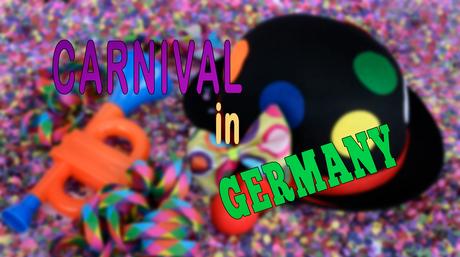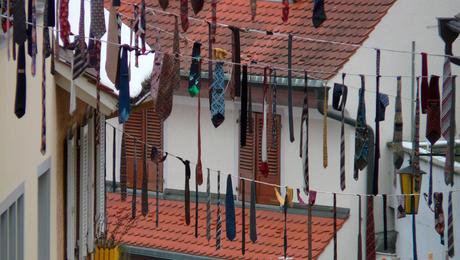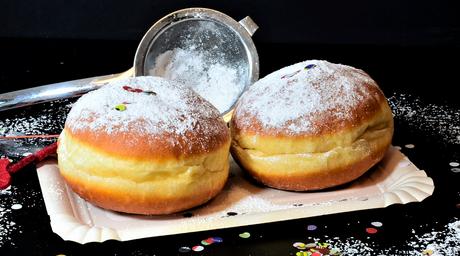
In case you visit Germany* in January or February, you will probably often hear a word during this time which is “Fasching” [faʃiŋ]. Fasching is the main term for the German carnival period. It’s also called the “fifths season” and in some places jesting time (närrische Zeit). But it’s very different to the carnival you maybe know from Brazil. For in February in the northern hemisphere, it would be difficult to dance on the streets in light clothing. Therefore, the carnival time in Germany is about different things, but it’s also a huge event. In this article, I’d like to give you some insights about Fasching which would broaden your horizon. So read on, folks.
What is Fasching exactly?
When you ask someone in Germany, what Fasching is, the most people would probably say that’s the time when people celebrating the end of the winter. It’s not wrong but actually not really correct. Therefore, let’s take a closer look on it, folks.
The word “Fasching” appeared already in the 13th century in different forms (e.g. vaschang) and etymologically, it describes the period of the last consumption of alcoholic beverages before the Lent.
Derived from this, the event of Fasching could be understood as the period when people in the Middle Ages were excessively celebrating before the Lent. This tradition is still alive – today Fasching also ends, when the Lent begins. And during this time, people having a lot of fun.
The forerunners of the present Fasching were the celebrations in the 12th century during the so-called jester feasts. At those periods, it was allowed to parody the church, the church rituals, and clergy itself (which could be a heavy offense during the normal time).
When does Fasching start and end?

There are three stages of the carnival in Germany and all of them tied to a tradition. Let’s take a look on them.
The first stage of Fasching begins on 11th November. At this day, the carnival season is officially called out. There are also some organizational rituals and procedures carried out. But until the New Years Eve, the so-called Fasching meetings (celebrations) are organized very sporadically. In other words, the first stage mostly has a formal character, and is not worth for someone to visit Germany to celebrate Fasching during the first stage. Let me explain the background of the first stage before we take a closer look at the second stage.
We go back to the year 354 A.D. This is the year when Christmas became an official holiday on 25th December (in other words: terminus ante quem). Shortly afterwards, there was a so-called preliminary fasting established which lasted 40 days. During those 40 days, every foodstuff which didn’t match the rules of the Lent, had to be eaten. It was food like meat, eggs, lard, milk products, and so on. This preliminary fasting period began always at the 11th November which also was the St. Martin’s Day (also known as the Old Halloween). That’s why the first stage of Fasching starts on 11th November.
The second stage begins officially on 6th January. Up from this time, there are a lot of carnival events and masquerades are taking place. In general, you will find every weekend here and there carnival celebrations. But they all have one common thing: they are celebrated inside of buildings. That’s what the tradition demands.
How is Fasching celebrated indoors?
Imagine a large hall full with lines of tables and chairs for the crowd. At the head side, there is a stage where artists performing and entertaining the people. As a rule, there is a main speaker making jokes, usually about the politicians and other public events worth to be parodied. When he doesn’t speak, artists enter the stage and do whatever they are made up. Check out the video below to get an insight of one of those indoor carnival meetings.
The third stage of Fasching starts when the celebrations are taking place on the streets, and it lasts one week before the end of the carnival. But this third stage also follows a fix traditional process. So let’s take a closer look on it. We will begin with the so-called Women’s Carnival. In German it’s called “Weiberfastnacht” [v aɪ b ɐ f a s t n a: x t].
1. Women’s Carnival
This part of the German Carnival begins always on Thursday in the last week of Fasching and it marks the transition from the indoor celebrations to the outdoor festivities. Women’s Carnival also has a very long tradition from the Middle Ages. Back to those times women had no real rights, and everything in their life was dictated by the men. But at this special day, the women could do what ever they wanted.
Traditionally, the women were disguising and masking themselves as old, ugly hags at this day. Then they left the household and the children to the men and were partying without any men around them. As time was passing by, the tradition changed and hence, women started to dress up themselves as middle-class women. Nowadays, this dressing-up ritual is not obligatory anymore, and the women dressing up as they want.
Watch your ties at Women’s Carnival

Since the middle of the 20th century, there has been a new tradition established. If any of the women would see a man wearing a tie at Women’s Carnival day, they would cut it off as a symbol of deprivation of the male power. Of course, all of this under the sign of fun and in the name of carnival. So if you would like to allow them to do this, you can wear a tie you don’t need anymore.
2. Carnival on Friday, Saturday and Sunday
When the Women’s Carnival day is over, the tradition for the following festivities differ depending on the region in Germany. But they have one thing in common: during the next three days, there are everywhere Fasching parades taking place. Almost every village and town organizing those parades. The very first official carnival parade in Germany took place in the year 1397. So you can see how old the tradition is, folks.
Depending on the region, in the 19th century, the parades had in some places a parodical trait of the military parade. But since the year 1830, the themes of those carnival parades became more political. But the parody of politicians doesn’t limit on German politicians but on politicians worldwide.
So how does a Fasching parade look like? Usually, it’s a convoy of vehicles looking like statues, figures and other constructions. On some of those vehicles, people are standing and throwing candies into the crowd. Doing this, they are yelling “Helau” or “Alaaf” which is a typical jester shout during the carnival. Here I’ve got you a video with a typical Fasching parade, folks:
3. Wild monday
After the Women’s Carnival and the weekend, another traditional carnival day begins which is called “Rosenmontag” [ro:zənmɔntak]. Literally translated it means “Monday of the roses”. But the truth is, it’s not about flowers at all. It’s a derivation from the German dialect spoken in Cologne. “Rose” in Cologne German means to “frolic”. So “Monday of the roses” can be understood as a “wild Monday” which is the peak of the German carnival time.
During Rosenmontag, the biggest parades are taking place, especially in the strongholds of Fasching, like Cologne, Düsseldorf, Mainz, etc.
Rosenmontag is not an official holiday. But in those carnival cities where people are crazy for this event, they usually don’t need to go to work because the companies (not all of them) are exempting their employees from the work.
4. Fat Tuesday
This is the very last day of the German carnival before the Lent which begins at the Ash Wednesday. In English speaking countries this day is also know as Mardi Gras, Shrove Tuesday or Pancake Day. At this day, there are different traditions were established how to celebrate. Some cities in the region of Cologne organize at this day carnival parades. I guess, they do this because they know that it would be difficult to compete with Cologne at the Wild Monday.
Originally, Fat Tuesday was called “Confession Tuesday”. As a preparation for the Lent, Fat Tuesday should have been used as a day for the penance. At the same time, at this very last day before the Lent, people ate all the food which was left but not allowed to be eaten during the Lent. Therefore, Fat Tuesday can be understood as the last Fasching day where the consumption of lovely dishes and drinks is the motto of the day.
Berliner pancakes and Krapfen

By the way, one of the most traditional foods during the German carnival time is the typical German pastry called “Krapfen” [kra:pfən] which is filled with jam and fried in hot oil.
Other term for this pastry is “Berliner pancake”. According to a popular legend, Berliner pancake was invented by a Berliner baker in the year 1756 during his gunner service in the army. It turned out that he was unfit for the military service, but he was kept in the army as a baker. To express his thanks for this gesture, he created pieces of yeast dough shaped as cannonballs. As he didn’t have any oven, he fried them in hot oil in a pan over the open fire.
But to be historically correct, Berliner pancake were mentioned in the annals already in the 16th century. Back that time, they were unfilled and were baked in the oven. The term Krapfen can be understood as a synonym for Berliner pancake but it’s usually used in Bavaria, Austria and western Germany.
If you would say Krapfen in Berlin or in general, in northern Germany, people probably wouldn’t understand you. But fact is, that Krapfen were already known in Austria in the 13th century, and the first written receipt was mentioned in the year 1486. As you can see, wether Berliner pancake or Krapfen, it’s again all about a very old tradition.
Actually, you can get Krapfen during the whole year in every bakery in Germany. But traditionally it’s eaten intensively during the carnival as a tradition from the Middle Ages.
But attention please: during the carnival time it’s common to make jokes with Krapfen. Some of them are not filled with marmalade but with mustard! Usually, people buy several Berliner pancakes and bring them to work for the colleagues. One of them will be the “unlucky” one if he or she will bite into the “mustard surprise”.
Book a flight to Germany now*
How popular is Fasching in Germany?

At the beginning I wrote that Fasching is a huge event. But how popular is it statistically? In 2018 there was a representative survey carried out by the opinion research institute YouGov. It turned out that 28% of Germans don’t like Fasching. On the other side, there were also 28% of people who claimed to love Fasching. 41% were indifferent about this.
About 60% of Fasching opposers stated that one of the main reasons they don’t like about Fasching is the fact that the most people celebrate Fasching just because it’s a good opportunity to booze like there is no tomorrow. And that’s true, folks. I know a lot of people who like Fasching just because of that. They don’t know anything about the origins of Fasching. Only they want to do is to get hammered like hell.
Additionally, 48% of them stated that the exuberant mood is artificial and not authentic. 43% critisized that the streets are getting trashed.
Fasching lovers, on the other hand, enjoy the exuberant mood and don’t think, it’s artificial. Therefore, 63% of them stated that Fasching is a awsome change from the daily round. To watch the parade is a lot of fun, according to 53% of all votes. In general, carnival music and carnival itself create a good mood, so the Fasching lovers.
Okay folks, it’s got a pretty long article but believe me, it was just a scratching on the surface. To describe the whole topic about Fasching, it would fill entire books. There also are a lot of small cultural subtleties depending on the region in Germany. So the best way to learn the German carnival, is to visit Germany* and so see it with your own yes.
*Affiliate link: when you click on this link, no additional costs would arise for you and the product or the service will not become more expensive. When you decide to buy the product or use the service, I’ll get a little benefit from the provider which I would reinvest to keep this blog alive.
